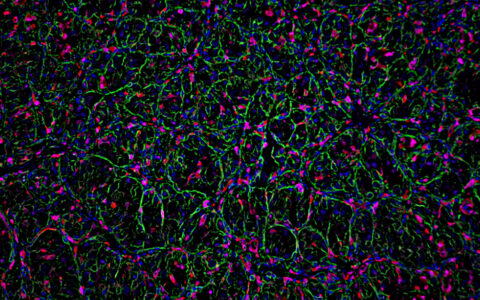Colorectal cancer rates have been declining in older adults, and on the rise in younger adults. Trends in appendiceal cancer tell a different story, with rates for all age groups on a steep upward trajectory, growing 232 percent between 2000 and 2016.
Perhaps because this malignancy is rare, with approximately 3,000 each year in the United States, the disease is understudied and is often presumed to share etiology and other characteristics with colorectal cancers.
Andreana Holowatyj, Ph.D., an epidemiologist and molecular biologist at Vanderbilt University Medical Center studying gastrointestinal cancers, says this assumption is being disproven.
“Appendiceal tumors harbor different molecular features from colorectal cancers,” she said. “They present and spread differently, don’t respond to the chemotherapy most colorectal tumors do, and they disproportionately affect younger adults. These cancers shouldn’t be conflated with those of cecal origin, particularly in tumor registries.”
Challenges for Diagnosis and Treatment
In the majority of cases, appendix cancer is discovered upon pathological evaluation of an appendectomy specimen when patients present with signs and symptoms for acute appendicitis. Often, this late discovery is made after the cancer has spread into the peritoneal cavity, Holowatyj said.
The potential misclassification of appendix cancer as a colon tumor is an obstacle to discovering disease-specific risk factors and tumor biomarkers, which has implications for risk assessment, screening, and surveillance, as well as treatment. With non-operative management of appendicitis becoming more common, Holowatyj is concerned that cases of appendix cancer may be missed for lack of occult tumors.
Appendiceal tumors may present as abdominal hernias, or fibroids, cysts or endometriosis in young women who experience pain or swelling/girth enlargement.
“Sometimes tumors are found in both the ovary and the appendix given proximity, and it is difficult to determine tumor origin versus site of disease spread,” she said.
Durable treatment options for patients with appendix cancer are still limited.
“A relatively small subgroup with appendiceal tumors of a particular histology may benefit from cytoreductive surgery and HIPEC [hyperthermic intraperitoneal chemotherapy],” she said. “Chemotherapy may help some patients, but generally does not have a curative or enduring benefit.”
A Population-based Study
With the rates of appendectomies remaining relatively constant, the steep rise in rates of appendix cancer and high proportion of younger patients is an entreaty for greater understanding. While approximately one in 10 colorectal cancer patients is under 50 years of age at diagnosis, Holowatyj discovered that the early-onset cancer burden sharply rises to one in three for appendix cancer.
“Appendiceal tumors present and spread differently, don’t respond to the chemotherapy most colorectal tumors do, and they disproportionately affect younger adults.”
Holowatyj first set out to characterize the burden of appendix cancer among young adults. She used the NIH’s Surveillance, Epidemiology, and End Results (SEER) cancer registries to identify 1,652 patients diagnosed with appendix cancer between the ages of 20 and 49 over a 12-year period. Her findings, reported in Gastroenterology, revealed five-year overall survival rates of 63 percent for non-Hispanic Black patients, 75.5 percent for non-Hispanic White patients, and 75.4 percent for Hispanic patients.
Histological subtype significantly differed by race/ethnicity, with non-mucinous appendiceal adenocarcinomas more frequent among Black patients compared with White and Hispanic individuals. Among those under age 50 with appendix cancer, nearly 20 percent were diagnosed with advanced stage disease (stage III/IV), and about 12 percent reported additional cancer diagnoses. Among young patients with mucinous and non-mucinous appendiceal adenocarcinoma, men had significantly lower survival rates than women.
Diving into the Genetics
Her team also found tumor-specific gene mutations that are not all typically observed in colorectal tumors. In a study published in JAMA Network Open, Holowatyj and colleagues revealed a distinct prevalence and spectrum of non-silent mutations in appendiceal tumors of patients age younger than 50 versus 50 years and older, setting the stage for the development of potential therapeutic modalities that target these unique molecular features.
While it is commonly thought that appendiceal cancer risk may not be heritable, Holowatyj thinks that this may not be the case. Her group is currently undertaking several studies exploring inherited gene mutations in appendix cancer, with their initial findings being reviewed for publication later this year.
“We hypothesize that health behaviors, potential environmental exposures, inherited and tumor-specific gene mutations, and gene–environment interactions may all contribute to heterogeneity in appendix cancer susceptibility and outcomes, as well as disease-specific disparities,” she said.
Future Investigations
In addition to her work to unravel a genetic link to appendix cancer, Holowatyj is probing for disease-specific risk factors for this malignancy, as well as aiming to improve the biological basis of disparities in early-onset cases.
“As a rare cancer, appendix cancer garners limited attention. Our team is passionately committed to driving marked advances in our understanding of this disease for our patients,” Holowatyj said.





